Etsy has transformed the online marketplace for vintage and handmade goods, but it’s not the only option for creative entrepreneurs. If Etsy’s fees or policies don’t align with your business goals, several compelling alternatives ⇣ can help you showcase and sell your unique creations.
Etsy remains the go-to platform for artisans, crafters, and vintage collectors. However, the e-commerce landscape has evolved, offering more choices for sellers seeking greater control over their online presence.
Based on my experience selling handmade jewelry, here’s a quick rundown of top Etsy alternatives:
- Best for scalability: Shopify offers unparalleled flexibility as your business grows. Its robust features and app ecosystem allowed me to start small and expand without changing platforms.
- Best for design-conscious sellers: Squarespace stands out with its stunning templates. I found its drag-and-drop tools intuitive, creating a professional-looking store that showcased my products beautifully.
- Best budget-friendly option: Wix provides excellent value for new sellers. Its user-friendly interface and Etsy integration helped me transition my existing listings seamlessly.
Etsy’s 2005 launch revolutionized how artisans and vintage sellers reach customers globally. For newcomers to e-commerce, it remains an excellent starting point, offering a built-in audience and simplified selling process.
Beyond product sales, Etsy’s community aspect is unique. I’ve found valuable connections with fellow crafters, gaining insights on pricing strategies and market trends. The platform’s high traffic volume can significantly boost visibility for new sellers.
However, if Etsy’s fee structure or policies don’t suit your business model, exploring alternatives is wise. Each platform I’ve listed offers distinct advantages for different types of sellers, from those seeking more creative control to those planning significant business expansion.
Top Etsy Alternatives in 2024
Drawing from my experience selling on multiple platforms, here’s an in-depth look at the best Etsy alternatives for handmade and vintage sellers:
1. Shopify
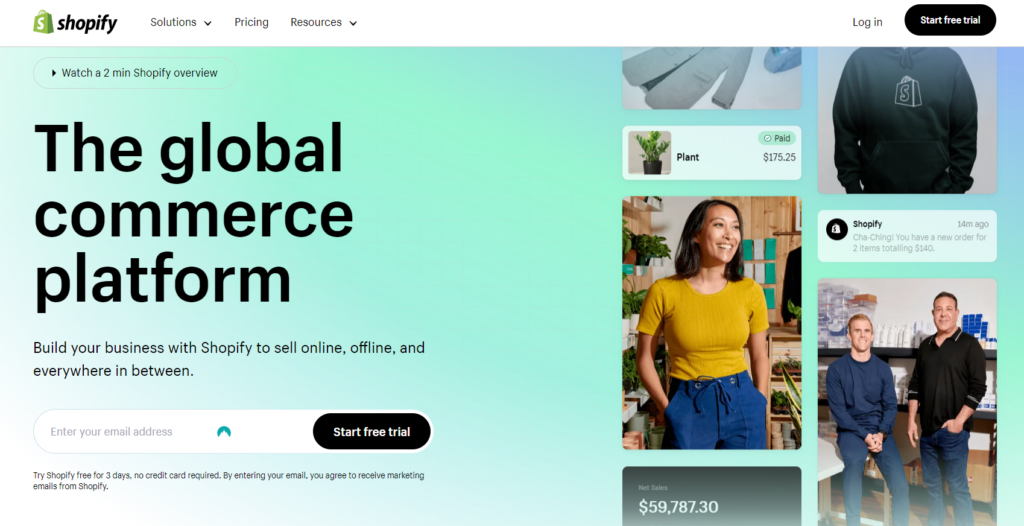
Shopify is for online businesses, both big and small, no matter what you’re selling. It is an easy-to-use and one of the popular Etsy alternatives for selling online. Shopify offers multiple themes to choose from, Buy Buttons that can be embedded into other websites, like WordPress, and a number of add-ons that can be downloaded to further customize your store.
Pros and cons
Pros
- You don’t need to be tech-savvy to manage your store
- Wide selection of storefront themes
- App store
- 24/7 support
- Marketing tools & SEO
- List unlimited products
- Free SSL certificate
- See my Shopify review for more information
Cons
- Only 10 free themes are available
- Gets a little pricy, with Shopify pricing plans starting from $29/month.
- Limited customization
Why Shopify is Better Than Etsy
When it comes to an all-inclusive e-commerce platform, Shopify is better and a more convenient solution. You are not limited to just handmade or vintage items, you can sell digital products, event tickets, lessons and workshops, memberships, and even take donations.
Overall, Shopify isn’t as restrictive as Etsy in terms of product sales and site ownership (you can use your own custom domain name). You also don’t have to deal with the massive competition that comes with a marketplace community like Etsy.
Summary: Shopify is the world’s leading e-commerce platform known for its comprehensive features, scalability, and ease of use. It provides an extensive array of themes, apps, and integrations, making it an ideal choice for businesses of all sizes looking to build, customize, and manage their online stores.
2. Squarespace
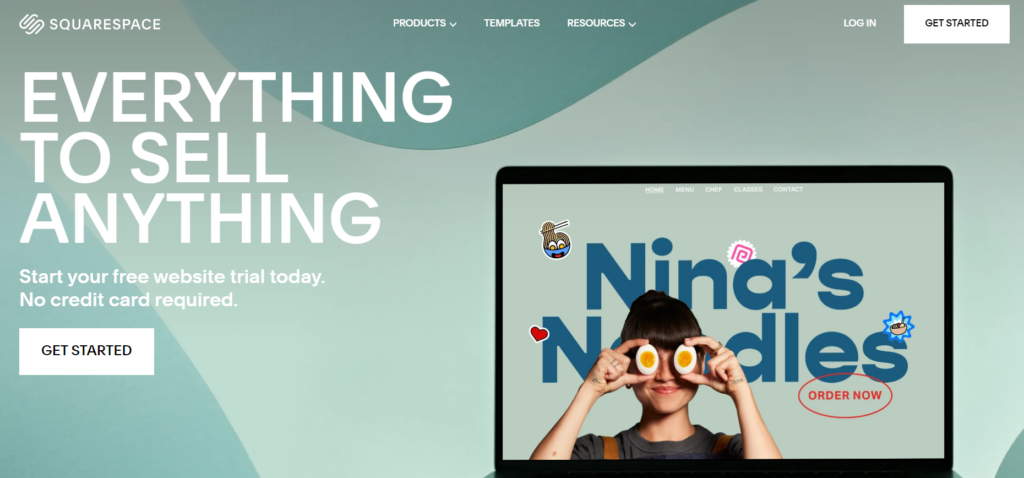
Squarespace is a website builder complete with top-notch, stylish, and sleek mobile responsive themes. Its e-commerce platform allows you to sell unlimited products of any kind, automatically manage your inventory, and customize your store’s appearance.
Pros and cons
Pros
- Great selection of themes, both free and paid
- Minimal fees and affordable plans
- Unlimited listings
- Can accept donations
- Analytics tools
- Professional features and tools
- See my Squarespace review for more pros
Cons
- No built-in audience
- Self-advertised and promoted
Why Squarespace is Better Than Etsy
In terms of themes and beauty, Squarespace beats Etsy. The changes users may make on the Squarespace themes are pretty much limited to colors, typeface, and some layouts, but they are so well-designed that there is little need to go through a major customization process.
For $23/month, the Business plan will allow you to create a fully integrable e-commerce site. Even better, if you upgrade to one of the two top plans, you will not be charged the 3% transaction fee.
Summary: Squarespace is a website builder with robust e-commerce capabilities, focusing on clean design and user-friendly interfaces. With a range of built-in templates, inventory management tools, and marketing features, Squarespace is an excellent choice for small businesses and creatives looking to establish an online presence.
3. Wix

Another user-friendly drag-and-drop website builder Wix, holds the promise of easy website building for the user who knows nothing about web design. It will even generate a webpage layout for you just by answering a few questions. However, more than that, it allows you to grow your business without having to give up Etsy entirely.
Pros and Cons
Pros
- Wix drag-and-drop editor
- Artificial Design Intelligence
- Independent App Market
- Email Lists
- Fully integrates with Etsy
- The basic plan includes a free domain for one year
- See my Wix review for more features
Cons
- Once you choose a template, you cannot change it without changing your website’s content
- A bit pricier than other commerce options
Why Wix is Better Than Etsy
In this case, it’s not a matter of what makes Wix better than Etsy, but rather why you should create a Wix site in addition to Etsy. Because Wix understands Etsy’s success as a marketplace community, it doesn’t want its users to have to give up those benefits.
Simply download the Wix Etsy App and you can connect to your Etsy store instantly. Combined with Wix’s email list creator app, you can better connect to your Etsy customers and not have to give up all that built-in traffic.
Summary: Wix is a versatile website builder that also offers e-commerce functionality. With its intuitive drag-and-drop editor, customizable templates, and various sales and marketing tools, Wix is well-suited for entrepreneurs and small businesses seeking an easy-to-use platform to create and manage their online stores.
4. SquareUp (Square eCommerce)
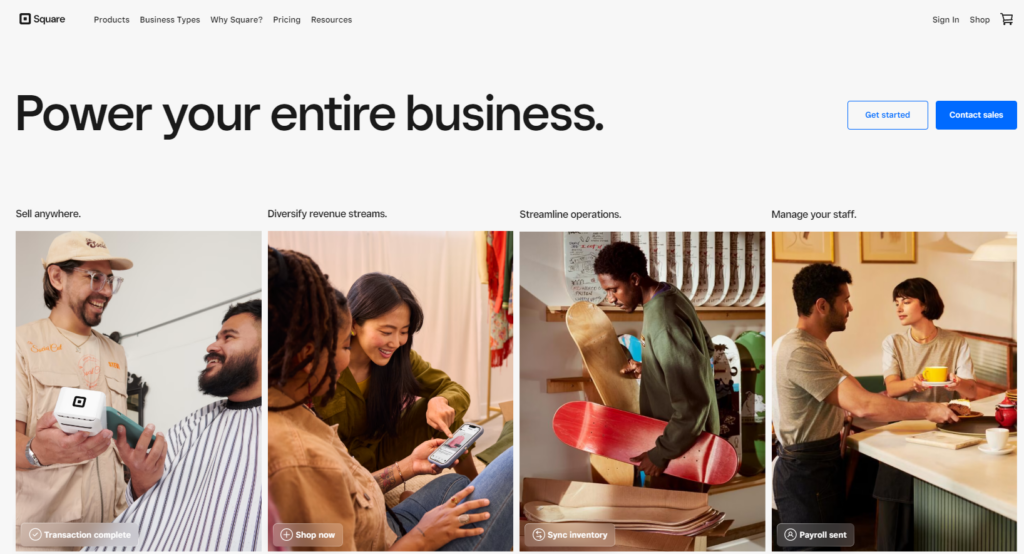
You may know Square as the payment platform that brought in-store transactions into the future, with tablet credit card swipes and smartphone attachments. However, Square is capable of much more, including an online store. SquareUp is free to use and comes with unlimited listings, you only pay a transaction fee plus $0.30 when you make a sale.
Pros and cons
Pros
- Free online store
- Zero monthly fees
- Instagram, Pinterest, Square POS integrations
- SEO
- In-store pick-up option
- Inventory Management
- Coupons and Gift Cards
- Contact Forms
Cons
- Not ideal for larger businesses
- Poor customer support
- Add-ons can get expensive
Why SquareUp is Better Than Etsy
If you are a small business who handles a lot of in-person sales, switch to Square! Etsy comes with its own mobile app, but Square is online e-commerce, POS, and an inventory management system all in one.
It also allows users to bounce between online and physical transactions with ease, making it great for the DIY crafter who makes frequent appearances at vendor events. It’s also good for the seller who needs an efficient, bare-bones solution who doesn’t prioritize store design customization.
Summary: SquareUp (Square eCommerce) is an e-commerce platform that seamlessly integrates with Square’s point-of-sale system, providing a unified solution for both online and in-person sales. Its simple setup, inventory management, and payment processing capabilities make it an attractive option for small retailers and service providers.
5. Storenvy
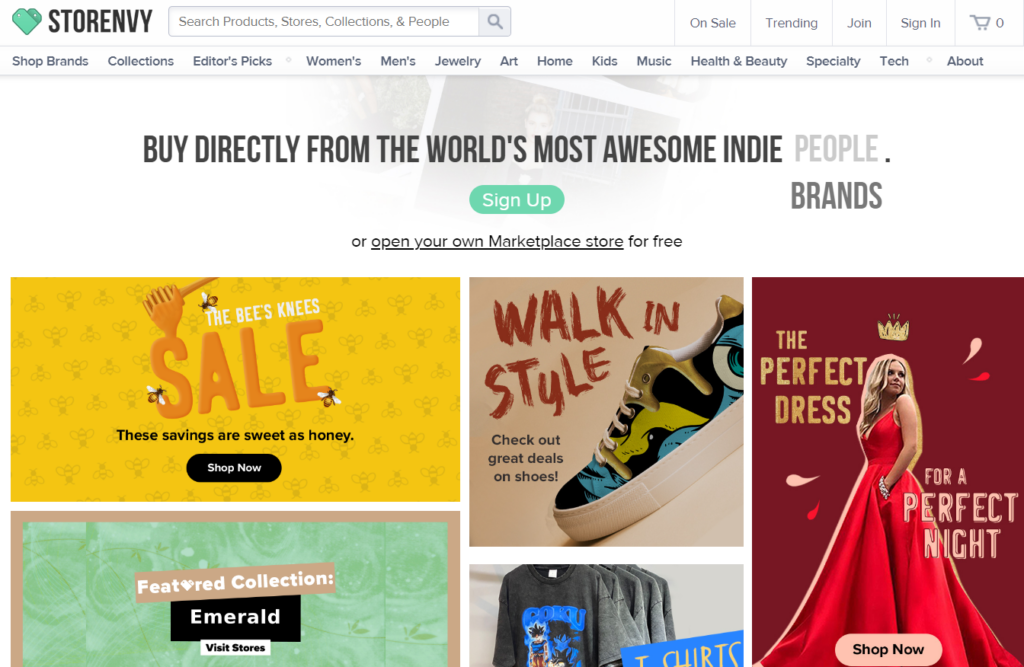
Like Etsy, Storenvy is a social marketplace for independent sellers to sell art, crafts, and housewares. It also allows for the sale of health and beauty, tech, and other specialized products. This global e-commerce outlet may allow manufactured goods, but it still provides a space for shoppers to find unique items and connect with small-business sellers. Sellers may also customize their storefront and use their own domain name.
Pros and cons
Pros
- Promotes and supports the sales of unique, handcrafted items
- Sellers can send discounts to interested customers
- No monthly or listing fees
- Analytics Tools
- Customizable storefront using CSS templates
- Item variation
- Cart Abandonments
Cons
- Individual crafters do “compete” against manufactured goods
- Commission fees are higher than other e-commerce platforms at 10%
- Minimal customer support
Why Storenvy is Better Than Etsy
What separates Storenvy from Etsy is that Storenvy will allow your store to grow as much as you want and need it to grow. Should your business take off and start manufacturing items, you won’t have to worry about not fitting into the strict handmade category Etsy requires.
Summary: Storenvy is a unique e-commerce platform that combines an online store builder with a social marketplace, allowing merchants to sell their products through their own customizable stores and a shared marketplace. This hybrid approach appeals to independent artists, designers, and small businesses looking to expand their reach and visibility.
6. Amazon Handmade
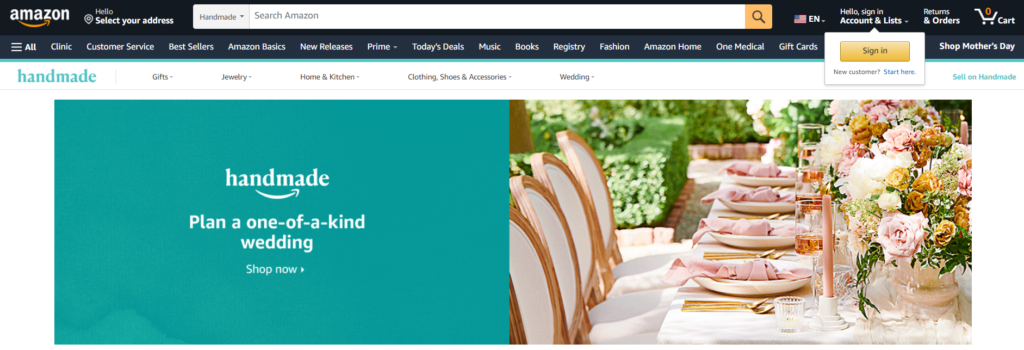
Good, ol’ Amazon. It seems to be taking over the e-commerce world in any way it can! In this case, however, it’s helping artisans take over the e-commerce world in any way they can. Amazon Handmade is an artisan-only e-commerce community and platform. Though its commission fee is higher than most, it does not charge anything to sign up, create a store, or list products.
Pros and cons
Pros
- The professional selling plan fee is waived for Handmade artisans
- Wide variety of categories artisans can sell under
- Huge customer base
- Friendly seller customer service
Cons
- No digital downloads or digital product sales
- 15% referral fee plus shipping costs
- Payment is not reflected in the seller’s account until the item is shipped
- Limited analytics
Why Amazon Handmade is Better Than Etsy
Make the switch to Amazon Handmade if you find that you’re ready to graduate from Etsy or make enough sales to justify adding another sales outlet. Unless you already have a pre-established and successful online business, I wouldn’t recommend using Amazon Handmade right away. It is not for beginners.
However, if you are ready for more visibility, switching to Amazon Handmade from Etsy is the difference between 40 million buyers to 103 million Amazon Prime subscribers. And you thought Etsy had a lot of traffic!
Summary: Amazon Handmade is a niche e-commerce platform dedicated to handcrafted and artisanal products, enabling artisans to sell their creations within the larger Amazon marketplace. With access to Amazon’s massive customer base and fulfillment services, Amazon Handmade is a powerful choice for crafters looking to grow their businesses.
7. WooCommerce
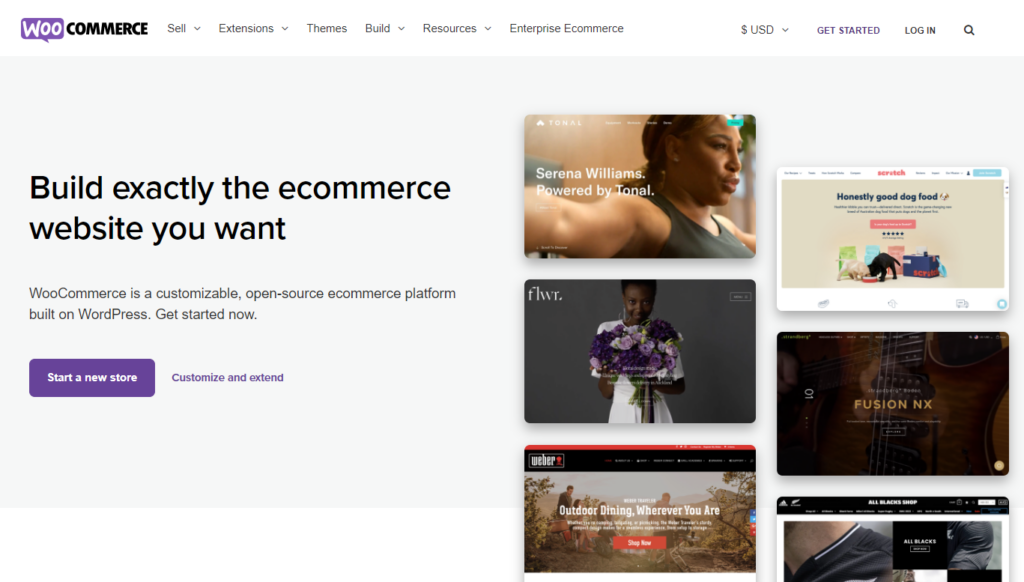
WooCommerce, developed by WordPress, is a reliable name in e-commerce and one of the most integrative and customizable platforms with which to sell your products. The difference between WooCommerce and the other options on this list is that WooCommerce is an e-commerce plugin. With WooCommerce, you can build an entire online store, independently owned by you, and follow your rules.
Pros and cons
Pros
- You make the rules for your store
- No extra transaction fees
- List any type of product
- Large selection of add-ons and extensions
- Import Etsy listings
- Includes WordPress blogging software
- Integrates easily with MailChimp, Google Analytics, Facebook, etc.
Cons
- A lot of updates
- Plugins can weigh down performance
- You need a hosting provider
Why WooCommerce is Better Than Etsy
If you want to start selling your product and already maintain a WordPress or other website through a hosting service like Bluehost, downloading the free version of WooCommerce is an easy way to get started.
Although at some point you may want to consider upgrading to a more professional plan, the free version will save you from having to rebuild an online community and the extra transaction fees implemented by third-party platforms. WooCommerce also gives you complete control over your online store.
Summary: WooCommerce is a popular, open-source e-commerce plugin for WordPress, providing a highly customizable and flexible solution for online stores. With a wealth of available extensions, themes, and integrations, WooCommerce is perfect for businesses seeking a tailor-made e-commerce solution built on the familiar WordPress platform.
What is Etsy?
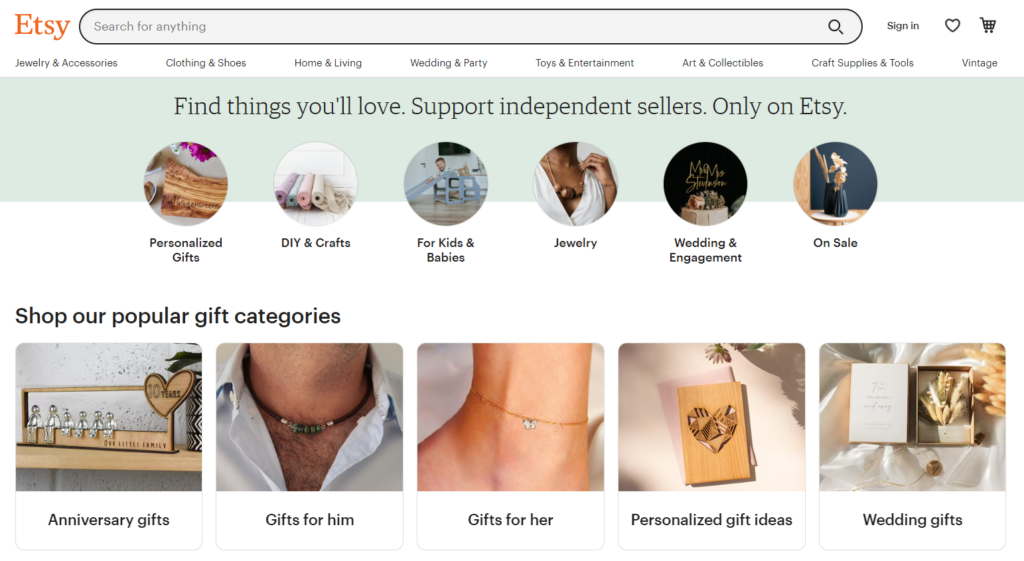
Sellers on Etsy typically sell jewelry, artwork, pottery, and other handmade housewares. Sellers can also market a vintage store.
Etsy is straightforward to use and comes with a great number of benefits.
It only takes $0.20 for users to sign up to start selling their goods and provides educational support on how to build a successful business using Etsy.
To create your Etsy account, navigate to the bottom of the page and under Sell, select “Sell on Etsy.” Click on “Open Your Shop” and either register your email to open the shop or log in with Facebook, Google, or Apple. Once you’ve confirmed your email with Etsy, you can access your shop settings under the account menu and get to selling!
Etsy features
There are pros and cons to virtually everything out there and Etsy is no exception. If you are wary of Etsy, the following list may help confirm or debunk some of those hesitant feelings toward the platform. However, it should be noted that regardless of Etsy’s cons, it is the first choice for many creative vendors out there for a reason.
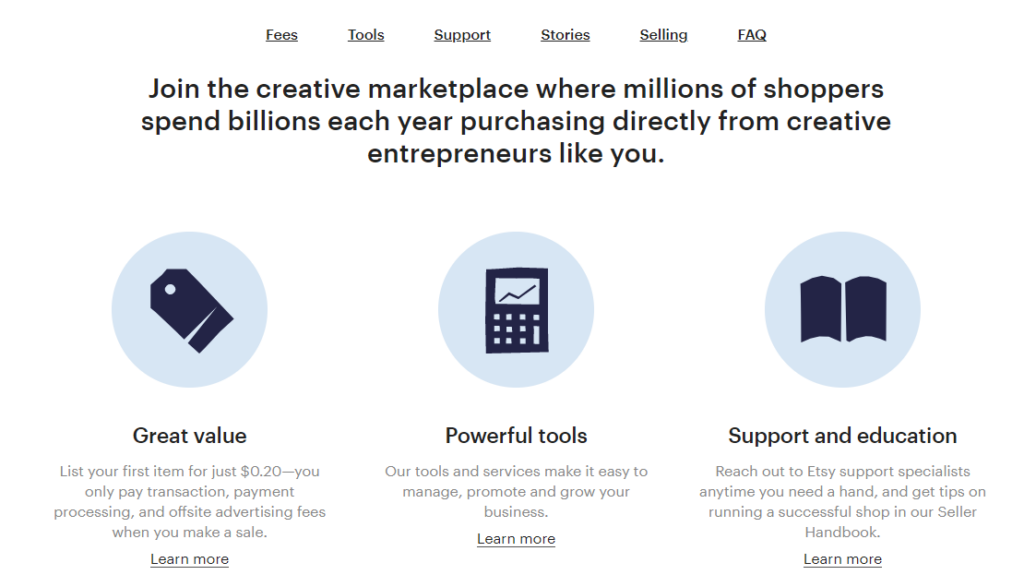
Etsy pros
- Encourages and supports the sales of homemade crafts, housewares, and vintage items.
- Mobile application that allows you to both sell and manage from your phone.
- Marketing online community.
- Sellers can buy and print shipping labels at a discounted price.
- Analytics tell you how you can better interact with customers.
- Easy-to-use interface and quick website setup.
- Signing up for Etsy Plus ($10/month) can get you the following benefits:
- Shop customization
- Custom shop URL at 50% off
- Alert customers to refilled stock
- Listing and advertising credits
The online marketplace also manages a Journal and Editors’ Picklist in order to showcase trends and ideas the Etsy team has discovered. This means that not only are curious customers looking at products, but team members of Etsy are as well. One of the biggest pros of Etsy is that you do not have to look for customers. Millions of people shop on Etsy regularly, and being part of those search results goes a long way for your business.
Etsy cons
- Many sellers mean bigger competition.
- You can only sell handmade and vintage items or craft supplies.
- House Rules: Sellers must follow Etsy’s rules and policies to a tee.
- Etsy does not integrate very well with email list services like MailChimp and there is no option for sellers to sign up for a newsletter from your store.
- The basic plan does not allow you to use your own URL.
Etsy fees
Etsy comes with a list of fees, which is one of the main reasons people make the switch from Etsy to another platform. Whether you consider this money well-spent or not, it is still money spent, which lands it on the con list.
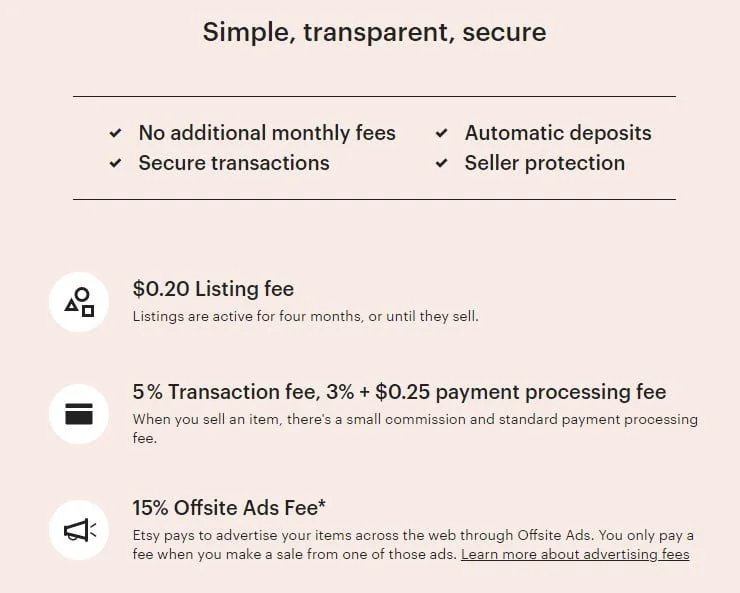
- Listing Fee: $0.20 for each listing, regardless of the sale. After 4 months, it will automatically renew the listing, charging you the fee again.
- Transaction Fee: 6.5% transaction fee. Etsy will charge you 6.5% of the total sale price.
- Etsy Ad fees. If you want to advertise on Etsy, you must pay.
- Offsite Ad fees. If you advertise through Etsy on one of their partner’s websites and someone clicks the ad and purchases your product within 30 days of that click, you will be charged a fee of either 12% or 15% depending on your yearly sales history.
- In-Person Selling Fees. If you sell an item through Square, whether you sync your products or not, you will be charged a $0.20 listing fee.
- Etsy Payments. If you choose to do transactions using Etsy Payments, you will be subject to a fee determined by where your bank account is.
- Pattern. The pattern allows users to create a customizable website. After a 30-day free trial, you will be charged $15/month.
- Currency Conversion Fee. If you decide to list a product in a different currency than your default one, you will be charged a 2.5% currency conversion fee.
If you do not pay your fees or take steps towards fee avoidance, it can mean trouble for you and your store.
Our Verdict ⭐
Etsy remains a solid choice for many sellers, offering a vast marketplace and built-in audience. However, as your business grows, you may find yourself needing more control or flexibility. That’s when exploring alternatives becomes crucial.
Start selling your products online today with the world’s leading all-in-one SaaS e-commerce platform that lets you start, grow, and manage your online store.
Start a free trial & get three months for $1/mo
Shopify stands out for its versatility. In my experience, it’s particularly well-suited for sellers ready to scale. Its robust app ecosystem allowed me to add features like advanced inventory management as my product line expanded.
Squarespace excels in design. When I transitioned my jewelry business from Etsy, Squarespace’s templates helped me create a stunning storefront that truly showcased my work. For those prioritizing aesthetics, it’s hard to beat.
Wix offers a great balance of ease-of-use and customization. Its drag-and-drop interface made setting up my store a breeze, and I found its learning curve gentler than Shopify’s. It’s an excellent choice for beginners or those wanting a quick setup. (For a detailed comparison, see this Wix vs Squarespace analysis).
SquareUp shines for sellers who do a mix of online and in-person sales. I’ve found its integrated payment processing and point-of-sale system invaluable for craft fairs. Storenvy offers a unique blend of marketplace and independent store, which helped me maintain the community feel of Etsy while building my brand.
Amazon Handmade leverages the enormous traffic of Amazon, potentially exposing your products to millions. However, be prepared for stiff competition. WooCommerce provides unparalleled control if you’re comfortable with WordPress. I use it for my most customized store, though it required a steeper learning curve.
Each platform offers distinct advantages, and the best choice depends on your specific needs. Consider factors like your technical skills, desired level of customization, and long-term business goals when making your decision.
Our Review Methodology
When we review e-commerce tools we look at several key aspects. We assess the intuitiveness of the tool, its feature set, the speed of website creation, and other factors. The primary consideration is the ease of use for individuals new to website setup. In our testing, our evaluation is based on these criteria:
- Customization: Does the builder allow you to modify template designs or incorporate your own coding?
- User-Friendliness: Are the navigation and tools, such as the drag-and-drop editor, easy to use?
- Value for Money: Is there an option for a free plan or trial? Do paid plans offer features that justify the cost?
- Security: How does the builder protect your website and data about you and your customers?
- Templates: Are the templates of high quality, contemporary, and varied?
- Support: Is assistance readily available, either through human interaction, AI chatbots, or informational resources?
Learn more about our review methodology here.

